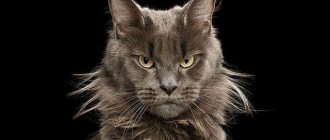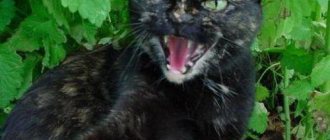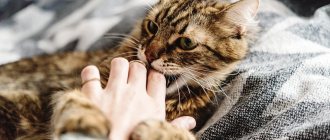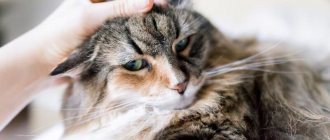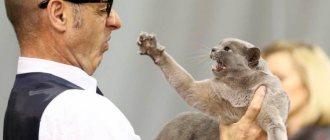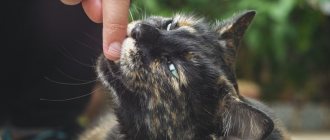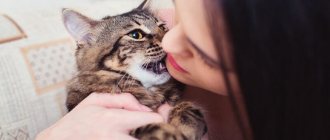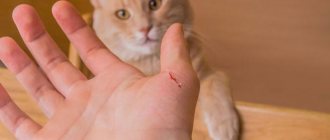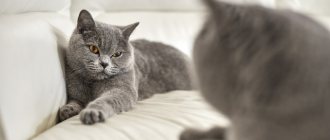The Maine Coon is one of the largest domestic cats, second only to the huge Savannah. Moreover, representatives of this breed are perfect for keeping even in small apartments.
Tassels on the ears, a muzzle with a “box” characteristic only of Maine Coons, powerful paws and impressive size give them some resemblance to a lynx. The brutal appearance sometimes gives a deceptive impression: people who are not too familiar with this beautiful breed mistakenly believe that such cats are independent and have a stern disposition. In fact, according to reviews from breeders and owners, everything is exactly the opposite - these gentle animals are completely alien to aggression, they are deeply attached to humans and, in most cases, are gentle and reverent towards children.
If you have long dreamed of having a representative of the feline family live in your home, but can’t make a choice, we suggest you think about this breed. Read all about what a Maine Coon looks like, what you should pay attention to when buying a kitten, and how to properly care for noble giants .
Maine Coon. History of the breed
Little is known about the origin of these beautiful animals. There are several versions about where these beauties came from. Some of them sound like legends. According to one of them, Maine Coons are the product of crossing a cat and a female raccoon. Hence the second name of the breed - raccoon cat. According to another - a lynx and an ordinary cat. This idea is suggested by the unique tassels on the ears. Scientists have disappointed lovers of legends. Such crossings are impossible.
Some researchers connect the history of the origin of Maine Coons with the Vikings. They claim that North American longhaired cats are direct descendants of Norwegian forest cats, which were brought to America by the Scandinavians in the 11th century. Sailors, setting out on a voyage, stocked up on food. To prevent rats and mice from destroying it, they took cats with them. Allegedly, several of them escaped from the ships and remained in America.
Some Maine Coon lovers insist on the royal roots of the breed. In their opinion, American cats are descendants of the fluffy Angora cats of the French Queen Marie Antoinette. In the 17th century, she was preparing to escape the French Revolution overseas. Trusted servants loaded things and furry pets – the queen’s favorites – onto the ship. However, at the hour of departure the royal personage had not arrived. The wife of Louis XVI was detained and subsequently executed by guillotine. The ship arrived in America with cats, but without an owner. There was no one to care for the animals. They went wild. Merged with the wild nature.
According to another version, North American cats are descendants of European cats that arrived in America along with immigrants from Europe. Thanks to their crossing with local representatives of the cat world, modern Maine Coons were formed.
Scientists reject all these versions and classify Maine Coons as aboriginal cats. In their opinion, the ancestors of these cats originally lived in Maine. They are representatives of the local fauna. People have domesticated them to protect crops from mice and rats. For many years, animals and people lived side by side, but each with their own lives. Farmers had no idea that their pets could be of any value.
The situation changed in 1861. A cat named Captain Jenks from the ship "Sea Horse" was first presented at exhibitions in New York and Boston. He not only won them, but also became the first officially recognized Maine Coon. In the USA, the breed began to gain popularity. But it didn't last long. By the end of the 19th century, Persian cats came into fashion. The Maine Coon cat breed was forgotten for many years.
They were remembered again in the middle of the 20th century. The Central Maine Cat Club was founded. Since then, exhibitions have been held there annually to identify the best cat - the state champion. In 1967, a breed standard was adopted in the United States. In 1980, about a thousand owners of such pets were registered in America. From America, raccoon cats came to Europe.
In the early 90s of the 20th century, North American cats were brought to Russia. Soon in our country the breed won the hearts of people.
Unique voice
From birth, all Maine Coons have a uniquely gentle voice, which becomes louder over the years, but still not louder than the voice of ordinary cats. It’s strange that no one has thought about recording an album with them yet. After all, it is only because of the bird's voice that it is worth having at least one of them. If you have never had a parrot or any other bird, then you can start with a Maine Coon; by ear you won’t even notice the difference. Don't believe me? Be sure to check it out for yourself. It’s easy to describe this voice, it is similar to the voice of a magpie, only in terms of energy it is many times stronger and brighter, especially when Maine-kun asks for food! Scientists have not yet agreed on why Maine Coons have such a voice; many complain about special vocal cords, but it is worth noting that if an ordinary cat’s voice becomes different over the years, then in a Maine Coon it simply becomes louder!
Types of Maine Coons
There are two types of Maine Coons:
- European
- American.
American
American raccoon cats are distinguished by their large size, wide bones, and simple head shape. The forehead is high and convex. The transition from it to the muzzle is pronounced. The vibrissae are long. The eyes are round. The ears are set high and small. The chest is wide. Well developed muscles.
The Maine Coon's tail is long. Its fur is luxurious: lush and long. It not only decorates the animal, but also warms it from the cold. If necessary, the cat lies down in a ball, wraps its tail around its body and warms itself.
The wool is silky and water-repellent. This helps the animal feel good in the snow and rain.
American Maine Coons are characterized by a tabby or wild color. Darker or brighter stripes on the main coat color. This color is typical of native cats. He allowed their ancestors to hide and camouflage themselves in the forests from their enemies.
European
Europeans are distinguished by their elongated, graceful body and long tail. It exceeds the length of the outstretched hind legs. Slightly elongated and large muzzle. The eyes are slightly narrowed, which gives them a predatory expression. The ears are large, erect, with pronounced tufts at the tips. The coat is less fluffy. There is no lush mane on the chest and pants on the hind legs.
European Maine Coons have predominantly uniform colors. Among them is smoky, which is not typical for Americans.
The European type was formed in the 70s of the 20th century. Breeders sought to improve the breed. First of all, this concerned external data. The character of European Maine Coons is no different from American ones.
Attitude towards other animals
Maines tend to live in small groups; they can easily adapt to the presence of other animals in their space. If there is another pet living in the house, then the Maine Coon will easily find a common language with him, will play and feel quite comfortable.
For hamsters, guinea pigs and pet rats, it is important to remember that the raccoon cat's genetics include the ability to hunt.
Small animals awaken this instinct in them and become a signal to action. In this case, life in the same space will not work out for pets.
Oddly enough, this is especially true for aquarium fish. Cats simply catch them with their paws and eat them.
Who is Maine Coon Polydactus?
The Maine Coon polydact cat differs from the classic representatives of the breed by the presence of additional toes on its paws. At the beginning of the 20th century, most North American cats had the polydactic gene. It was passed on from parents to Maine Coon kittens. If classic cats have 18 toes on their paws - 5 on the front paws and four on the back paws, then polydacts can have 20 or 22. For this they are called cats with mittens.
Thanks to their wide paws, North American cats easily move through loose snow and more easily provide themselves with prey.
There is a belief that cats wearing mittens bring good luck to their owners. In the 14th – 20th centuries, sailors believed that they were protecting the ship from shipwreck. Therefore, such individuals were gladly taken on ships.
Many famous personalities have owned six-toed cats. Among them were Franklin Roosevelt and Ernest Hemingway. For this reason, six-toed Maine Coons are often called Hemingway cats.
For a long time, breeders struggled with the genetic mutation. Six-toed Maine Coon cats were taken out of breeding and were not allowed to attend exhibitions. In the 21st century the situation has changed. Interest in such animals has increased. Their prices have increased. As a result, some nurseries deliberately breed polydacts.
Owners of Hemingway cats claim that the character of their pets is the same as that of classic Maine Coons.
They are friendly but not tame
It is almost impossible to tame a Maine Coon completely; they have a wayward, daring character that they retain for the rest of their lives.
Probably everyone has seen photos in which people hold Maine Coons and straighten them to their full width, and you can see how huge they are.
They are really larger than ordinary cats, it’s all about special selection. It’s not for nothing that this is considered a royal breed of cats, since they are from those same Imperial times. If you manage to tame such a “miracle”, then you should definitely think about a circus career! He is the owner of the house and not you, and it is better for you not to argue with this, otherwise there will be a lot of scratches, and it is better not to lead to bites
Maine Coon character
- Behind the harsh appearance of Maine Coons lies a sociable and affectionate creature. Pets love to be stroked and caressed. However, they get irritated when people try to pick them up and cuddle them. As a rule, they break away and leave. If you hold them at this point, they may scratch.
- The Maine Coon is a one-owner cat. He chooses him from among the family members himself. How a dog remains faithful to him all his life.
- These cats do not like to sit on their owner's lap. Due to their large dimensions, they do not fit there well. They prefer to be placed at the feet of the owners or nearby on the sofa.
- By nature, raccoon cats are calm. However, they are not the type of pet that naps on their beds all day. They are lovers of an active lifestyle. They need communication and movement. They don't know how to sit idle.
- The owner of a Maine Coon must be prepared for the fact that the pet, despite its large size, will climb onto cabinets and shelves. As a result, fragile items will end up on the floor. It is better to put them in a safe place in advance.
- They mature late - by the age of 3. However, even in adulthood they retain spontaneity and playfulness.
- The blood of hunter ancestors flows in the veins of domestic cats. They love outdoor games. They like to catch and chase. For example, running after a ball. The pet will feel happy if the owner finds time to play with it.
- They have high intelligence. Their habits are similar to dogs. They are highly trainable. They are easy to teach various tricks. They are able to master dozens of commands. Among them: “sit”, “lie down”, “fetch”, open doors, bring slippers to the owner. Understands gestures and facial expressions. Cats need to be trained in a playful way. Otherwise, four-legged students will lose interest in “science.”
- Curious. They often imitate their owner. For example, they may sit with family members on the couch and watch TV attentively.
- They are sincerely attached to the owners. Unlike other cats, Maine Coons are not capricious. Not inclined to demonstrate independence. They can't stand loneliness. They feel more comfortable and happy in the company of family members.
- Delicate. They will never impose themselves if a person is busy with business. They are content to be nearby and watch what is happening around them.
- By nature, Maine Coons are non-conflicting. They get along well with other animals and children. The pet becomes tightly attached to the kids. Plays with them and takes care of them. However, it is necessary to ensure that children do not offend the cat. The animal is able to understand when it was hit or pushed accidentally. But if this is done intentionally, the cat will turn around and leave. He will not take revenge on the little tormentor.
Content
The Maine Coon is not an ordinary breed. Due to their physiological characteristics, they require somewhat higher maintenance costs than cats of more modest sizes.
When planning to get a little coon, many people wonder how much kittens cost. Prices for purebred animals from good nurseries start from 20 thousand rubles (if you are very lucky) and can reach 100 thousand and above - depending on the title of the parents and the objectives pursued by the buyer. Naturally, a kitten of the so-called pet class, which is destined to become just a pet, will cost several times less than a candidate for a successful exhibition career, although both of them can ultimately grow into luxurious giants with outstanding breed characteristics.
However, it is not enough just to buy a kitten from wonderful parents, even for a lot of money. The main thing is to provide him with decent care and maintenance.
Representatives of this breed feel great both in a city apartment and in a country house. Of course, the second option is ideal due to more free space and the ability to regularly breathe fresh air. If you live in your own home, your number one task is to provide a safe walk for your pet. Despite their impressive size and harsh appearance, these cats are completely unsuited to life on the street and will not be able to protect themselves in case of danger. They are not very agile, and they don’t know how to fight at all. The times when they protected North American farms from rodents are long gone, and the modern Maine Coon is a friendly companion, not a cunning and resourceful hunter. The best thing you can do for your four-legged mustachioed friend is to build a spacious enclosure, closed on all sides, with access directly from the house. Place logs and branches of various configurations and sizes inside, and your pet’s gratitude will know no bounds. Such a walking area will provide your pet with the necessary amount of fresh air and sun, and will also satisfy the need for games and movement.
If you are not the happy owner of your own house in the village, then it is quite possible to provide a coon with decent living conditions in a city apartment, but with reservations regarding the dimensions of the new home. Maine Coons have a calm and balanced character, but the kittens are not averse to frolicking, and if you take into account the fact that they remain kittens for up to three years, and their weight by the year can reach 10 kg, then it becomes clear that everything is easily breakable and represents It is better to remove artistic value away.
Also, do not forget to protect your inquisitive pet from falling - never open windows wide if there is a cat in the room! Or place special grilles (not meshes!) in the openings.
To provide the coon with sufficient physical activity, the owner needs to think about purchasing a special play complex for cats. It should be high enough, but stable, with wide, spacious areas, hammocks or houses where the animal can relax and retire. At the same time, such a complex will act as a scratching post, keeping the upholstery of your furniture safe and sound. Such devices can be bought at a pet store or made to order. Many manufacturers have special lines for giant cats. Give preference to these, although they are somewhat more expensive. But your cat is also unusual, isn’t it?
If we talk about nicknames that are suitable for Maine Coons, then such a majestic animal needs an appropriate name. Among boys, Duke, Count, Viscount, Martin, Mars, Admiral, Patrick, Sean, Askold are often found. The girls are called Duchess, Adele, Olivia, Quinn, Stella, Ursa, Martha.
pixabay.com/
Care
Caring for cats is labor-intensive. Requires a lot of time and effort. The reward is a happy, beautiful and loving pet.
Check your ears and eyes regularly. If dirt and wax have accumulated in your ears, remove them with a cotton swab soaked in a special lotion.
The cat's eyes should be clear. If there is discharge in them, remove them with a special napkin. If there is none, use a swab moistened with boiled water or eye lotion. It is not recommended to use chamomile infusion. It has a bad effect on the hair around the eyes.
Wool
A kitten must be taught to care for its fur literally from the first days it arrives in the house. If you don't do this, he won't like handling the comb later. He will resist and may show aggression.
Starting from six months, kittens' coats change. The baby's undercoat falls out. The fur becomes thick and tough. To make this period pass faster, the animal must be combed at least twice a week.
In addition, during this period the pet’s body especially needs vitamins and microelements. If there are not enough of them, the period of baby molting will drag on for a long time. The appearance of the coat will deteriorate.
An adult animal sheds twice a year - in spring and autumn. For cats that live in apartments, their schedule is often disrupted. Shedding may occur earlier or later and may take longer.
In addition to seasonal molting, the coat is constantly renewed. Experts say that each hair on a Maine Coon “lives” for about a month and then falls out.
Regular brushing will help maintain the beauty of the coat and prevent the formation of tangles. Makes it easier to maintain cleanliness in the apartment.
If the cat is not brushed, he will lick the fur off himself. As a result, it will accumulate in the intestines, which can lead to health problems.
How to brush a Maine Coon
This must be done in several stages.
First, comb the animal with a wide-toothed comb. This will allow you to identify problem areas.
Most often, hair rolls up behind the ears, on the stomach, chest, lower neck, and hind legs.
Carefully remove any tangles found with your hands. Try combing. If that doesn't work, cut them out with scissors.
After this, comb the coat with a fine-toothed comb. This will remove the undercoat and “outdated” hairs.
Bathing
Maine Coons love water. If babies are introduced to water baths from an early age, they will begin to enjoy the procedure.
You need to bathe your cat in warm water – 35 degrees. Place a rubber mat or towel on the bottom of the bath to prevent your pet from slipping and falling. Make sure that water does not get into your pet's ears.
Maine Coons need to be washed with special shampoos for long-haired cats. Then rinse with water.
Upon completion of the procedure, the animal should be dipped in a soft towel. If you rub too hard, the fur may become tangled.
After the bath, make sure that the cat does not get caught in a draft and catch a cold. To prevent this from happening, dry the fur coat a little with a hairdryer. Then let the cat finish the job himself - lick the fur.
Nail care
Cats themselves monitor the length of their claws. If necessary, grind them off or bite off the ends. However, the owner must keep this process under control.
Maine Coons need to sharpen their claws. To prevent cats from damaging the furniture in the apartment, it is necessary to install special scratching posts. If they are not there, then there is a high probability that upholstered furniture or door jambs will be damaged. Claw grinders must be well secured so that a large cat cannot turn it over or drop it on the floor.
It must be borne in mind that even if a pet uses a scratching post, this does not guarantee that he will put his claws in order on his own. It is necessary to control the length of your pet's claws, otherwise they will cause discomfort and problems for the raccoon cat.
The claws on the front paws are always longer than those on the hind paws.
If the claws are very long and cause discomfort to the pet, they need to be trimmed a little. This can be done at a pet salon, veterinary clinic, or invite a specialist.
The owner can trim the pet's claws himself. However, inexperienced people should not undertake this procedure. The claw contains blood vessels. If they are damaged, severe bleeding will occur.
Particular attention should be paid to the fifth toes on the front paws. These fingers do not come into contact with the ground or floor. Long claws grow on them and begin to bend at the end. Sometimes it grows into the skin. The pet is in severe pain. To prevent this from happening, the claws need to be trimmed on time.
If a cat breaks a claw while playing, its sharp tip must be trimmed. Otherwise, a fragment of the claw will damage the animal's paw. The wound must be treated with an antiseptic.
What to feed
The cat must be fed food prepared especially for it. Food from the owner's table is harmful to the pet. This is due to the characteristics of the animal’s digestive system, which differs from the human one. Food from the owner's table is poorly digested and can cause a number of diseases.
There are two options for feeding the animal:
- natural,
- industrial feed.
You can choose a natural diet for your pet only if you have the time to cook especially for him.
Foods that are good for Maine Coons
- Lean meat: horse meat, beef, lamb, rabbit, turkey, chicken.
- Offal: heart, tripe, liver.
- Vegetables: carrots, pumpkin, zucchini, cauliflower. They can
- Greens: parsley, dill, lettuce.
- Cereals: oatmeal, rice, buckwheat.
- Sea fish: hake, pollock, pink salmon.
- Chicken and quail eggs.
- Fermented milk products: cottage cheese, kefir, yogurt, Varenets.
- Vegetable oil. It should be added to vegetables and cereals 1⁄2 teaspoon. Sunflower, olive, flaxseed are suitable.
Forbidden food
- Fat meat. Causes disruption of the digestive system. Frequent use can lead to the death of the animal.
- Bones. Can injure the gastrointestinal tract.
- Milk. Causes indigestion.
- Beans. Lead to bloating and flatulence.
- Noodles. Buns and pies. Provokes gastrointestinal colic, bloating and diarrhea.
- You should not feed your cat salty food. Because of it, the risk of cardiovascular diseases increases.
An adult Maine Coon should be fed 2 times a day. To do this, the daily food intake should be divided into two meals.
The cat should always have access to a cup of clean water
If you don’t have time to prepare food for your cat, commercial food will help get out of the situation. Choose a product from one of three classes:
- premium;
- super premium;
- holistic.
Depending on the consistency, industrial feeds are divided into 2 types: dry and wet.
Each has its own advantages and disadvantages.
Dry food can remain in a cat's bowl for 24 hours. There is no moisture in it. When using it, your pet must be provided with access to clean and fresh water.
Wet food is available in the form of jellies and pates. It is well absorbed by the cat's body. It is not only nutritious, but also high in calories. Pets love him. If it is abused, the coon may become overweight.
You can combine dry food with wet food. In this case, dry food should account for 75% of the daily ration, respectively wet food - 25%.
Food for a Maine Coon should be selected taking into account age, health status and energy costs. It is important to follow the dosage specified by the manufacturer.
Requirements for maintenance and nutrition
If you are going to get a Maine Coon or already have a cat of this breed, you should know that caring for them is much more difficult than for other cats. In order for your pet to be cheerful and healthy, and for its coat to have a beautiful appearance, you need to pay great attention to it, and not forget about a well-designed diet.
Features of care
Basic requirements include examining the ears and eyes, brushing the coat, and trimming the nails. Features of care are as follows:
- wipe the eyes with a damp cotton pad, having previously moistened it in boiled water;
- ears are cleaned with special means or damp cotton wool, without using ear sticks;
- Teeth cleaning is carried out with a special paste; sometimes it may be necessary to remove a tooth when changing it;
- Every day you need to comb the hair with a blunt-toothed comb, bathing as necessary;
- trimming the claws - as they grow, very carefully so as not to affect the living area with capillaries.
When tangles form, they should not be wetted, as water makes them even denser. If possible, they are untangled and combed out.
Feeding rules
If you decide to go with dry food for your Maine Coon, it should be as nutritious as possible in order to meet the animal’s need for vitamins and microelements. Their deficiency leads to a deterioration in the pet's health. You should choose super premium food. A natural diet should contain large amounts of fiber, proteins and carbohydrates. It is worth including vitamins and supplements. At the same time, you cannot combine natural and dry food: problems with excess weight may arise. Be sure to provide your Maine Coon with constant access to plenty of clean water.
Education and training
Raising a four-legged baby begins from the first day it arrives in the house. Despite the fact that many Coon owners call them Cotops, this should not be taken literally. Raccoon cats will never unquestioningly, like dogs, follow commands. They are self-sufficient. However, they will be happy to perform tricks to cheer themselves up and please their owner. They can be taught to fetch balls and serve slippers. Sit and lie according to a person's gesture.
It is necessary to teach pets this wisdom in the form of a game. It is important to reward with a treat for a correctly completed exercise. Don’t be surprised if your pet, on his own initiative, starts tearing down the slippers of all family members for tasty bites.
To achieve a good result, be patient. Show your pet attention and care. Then he will trust you.
Maine Coons cannot be beaten, deprived of food or toys, or shouted at as punishment. They do not tolerate violence. Such actions will provoke hostility and ruin the relationship with the animal.
Tray training
People buy kittens that are 3 months old. As a rule, kids already know what a tray is. But they may get confused in a new home. To prevent this from happening, the owner should show the pet a place to relieve itself.
You can guess that a kitten wants to go to the toilet by its behavior. He is worried, looking for a secluded corner. At this point, it should be carefully transferred to the tray. To attract your baby's attention, lightly scratch the litter in the cat litter with your finger.
If the kitten relieves itself before you move it to the litter box, wipe off the urine with a paper towel. Then put it in the litter. Next time the pet will find the tray by smell.
Training to a scratching post
Sometimes cat owners have a problem. The four-legged pet does not use a scratching post and scratches upholstered furniture. You can correct the situation in a simple way - show your pet where to sharpen its claws.
Place the kitten next to the scratching post. Take the kitten's paw and press down on the pad. Your pet will release its claws. Lightly move your baby's paw over the scratching post. After this, praise him and give him a treat. The pet will understand that it is possible to scratch in this place.
If after a while the kitten starts damaging the furniture again, take him to the scratching post again and show him where he can sharpen his claws. This should be done calmly and kindly so as not to scare the pet.
To better consolidate the result, use catnip. Lubricate the scratching post with it. The smell will attract the animal.
They don't like loneliness
Maine Coons always strive for the room where there is a person; without attention, they suffer greatly. They, as a rule, choose one owner and remain devoted to him for life. If your cat chose you out of all the family members, then you are very lucky, but there are disadvantages: he is unlikely to give you privacy in the toilet or shower. The doors in the room you are in should always be open. These animals generally hate loneliness: even if you leave the house for just a couple of hours, the Maine Coon will greet you with violent screams. But cats of this breed are easy to teach dog tricks. Our pet always comes when called and knows how to fetch. Some owners even boast that they taught their pet the “sit” command. It’s better for you to always be close, otherwise they may be offended by you and will never let you caress them again. Therefore, either take it with you always or don’t start it at all.
Maine Coon diseases
Representatives of the Maine Coon breed have good health. However, they are genetically predisposed to a number of diseases.
Hypertrophic cardiomyopathy. Heart disease. Asymmetric thickening of the ventricular wall occurs. All breeds of cats are prone to this disease.
Hip dysplasia is a disease of the musculoskeletal system. The consequence may be lameness.
Polycystic kidney disease. A hereditary disease that leads to kidney failure.
Spinal muscular atrophy. The nerve cells of the spinal cord are affected. Muscle weakness develops. Muscle atrophy occurs.
Record holders
The largest Maine Coon in history had a body length of 123 cm. The tail was 41.5 cm long. This cat had a gray-smoky color, and the record itself was recorded on August 28, 2010. His name was Stewie, he lived in the USA, in the state of Nevada. Another record holder lived in Australia, his name was Omar. He weighed 14 kg. It had a length of 120 cm.
Maine Coon record holder.
One of the most sensational records concerning this breed lived in Australia and had similar dimensions.
The largest cat by weight lived in the USA. He reached a weight of 16.5 kg, and did not have any health problems that could cause such a body weight.
No artificial records
In order to achieve records, many owners begin to overfeed the cat or even introduce special hormonal supplements to quickly gain height and weight, thereby harming its health. Large weight impairs the functioning of the heart, liver, digestive tract, and also leads to metabolic disorders. This way the animal can die much faster. All this led to the fact that many international exhibitions and competitions canceled awards in this category.
Photos of Maine Coon cats
How to choose a kitten
You must immediately decide for what purpose you are taking a kitten: for breeding or as a pet. The amount you will have to spend on the purchase depends on this.
All kittens are divided into three classes: pet, breed and show.
Pet class - do not participate in breeding. These are pets. As a rule, these animals have slight deviations from breed standards. But their price is much lower.
Breeding and show class kittens are purchased for participation in exhibitions and breeding. These coonlets are as close as possible to the breed standards.
All Maine Coon kittens are cute and cheerful. If you want a pet, you shouldn't spend all your savings on a show-class animal. Choose the one you like and who has enough money.
You need to decide whether you need a girl or a boy. Maine Coon cats are more affectionate and cunning. Males are straightforward in character and much larger in size than girls. Their weight can reach up to 10 kg. The weight of females is 2-3 kg less.
To purchase a kitten, contact a special breed nursery.
Before you make a purchase, check with. All Maine Coon kittens born from purebred parents must have documents, regardless of class. Pets are no exception. A negative answer is a reason to be wary. Perhaps they are trying to sell you a mestizo.
When visiting a cattery, familiarize yourself with the conditions in which the cats live. They should not be kept in cages. The room must be clean.
Pay attention to the condition of the animals. It's a bad sign if they are exhausted.
Before choosing a Maine Coon kitten, meet its parents. This will give you an idea of how your pet will grow up.
Ask the breeder any questions you want answered. The specialist will tell you everything about Maine Coons.
If the nursery is trustworthy, mom and dad like it, we choose a pet.
- The kitten should be moderately well-fed. Not fat. Not skinny.
- Check the condition of your eyes and nose. The mucous membranes must be clean.
- Play with your baby. Look how he runs and jumps. You will see how he moves. This will eliminate problems with joints and bones. A healthy baby is always active, mobile, and will not refuse to play.
- A good Maine Coon kitten should have large bones, massive paws, and a long body. As for the tassels on the ears, they are not required, but desirable. If the tassels have not appeared by two months, they will not appear again. What is more important is not the presence of tassels, but the correct placement of the ears. They should be large, vertical, set high.
- At three months, a Maine Coon kitten is the same size as an ordinary barn cat.
Its weight is at least one and a half kilograms. The minimum weight of a Maine Coon kitten can be calculated using the formula: the number of months is multiplied by 0.5 kg. At five months the kitten will have a minimum weight of 2.5 kg, at 6 months - 3 kg.
At what age should you take a kitten home?
You can take your baby home at the age of 12 weeks. You shouldn't do this before. The kitten must learn to eat food received in the nursery and use the litter box. He must receive the necessary vaccinations.
In addition, the breed characteristics of a kitten at the age of one month cannot be assessed. Even a professional cannot cope with this task.
If you liked a very small kitten from the nursery, leave a deposit for it. When he grows up, take him.
Appearance Features
It is worth knowing that at a young age it is quite difficult to notice the difference between animals. Thoroughbreds have similarities to ordinary ones, but they still have unique features. When inspecting, pay attention to:
- Ears. They are noticeably larger than those of ordinary pets, set almost at a right angle to the head, there is no forward bend, like in a Siberian cat. They are wide at the base and then gradually narrow. They end with a tassel - a unique external feature. The kitten can be born with it, more often it grows later, but by a maximum of 3 months there should already be a tassel on its ears. For this reason, it is better to select a pet at this age.
- Head. It is slightly elongated, since the length is slightly greater than the width. All features are clear, and the whisker pads form a “box”, making the muzzle square. The cheekbones protrude noticeably, which is not typical for ordinary domestic kittens.
- Eyes. They are slightly slanted and almond-shaped, unlike the rounded ones of other cats.
- Paws. Firstly, they are quite large even in babies, and secondly, tassels also grow on them - between the claws.
- Tail. This part of the body in purebred animals is long, about 2 times longer than in their domestic relatives. It is worth noting that selling Maine Coons is a profitable business, and there is a high risk of fraud. The breeder can tell that the tassels have not yet grown, the shape of the face sometimes seems similar, but the length of the tail can reveal the truth. Therefore, it is better to cooperate with reliable nurseries, where they will provide you with all the necessary documents.
- Wool. Even in kittens it is of medium length and thick.
- Dimensions. At the age of five weeks, Maine Coons are already comparable in size to a six-month-old ordinary kitten; at 4-5 months they “catch up” with an adult.
- Body type. It should be strong, the chest should be wide, the bones should be massive.
Also, purebred representatives of the breed are much more active and mobile than their ordinary counterparts, they develop faster and switch to food earlier.
